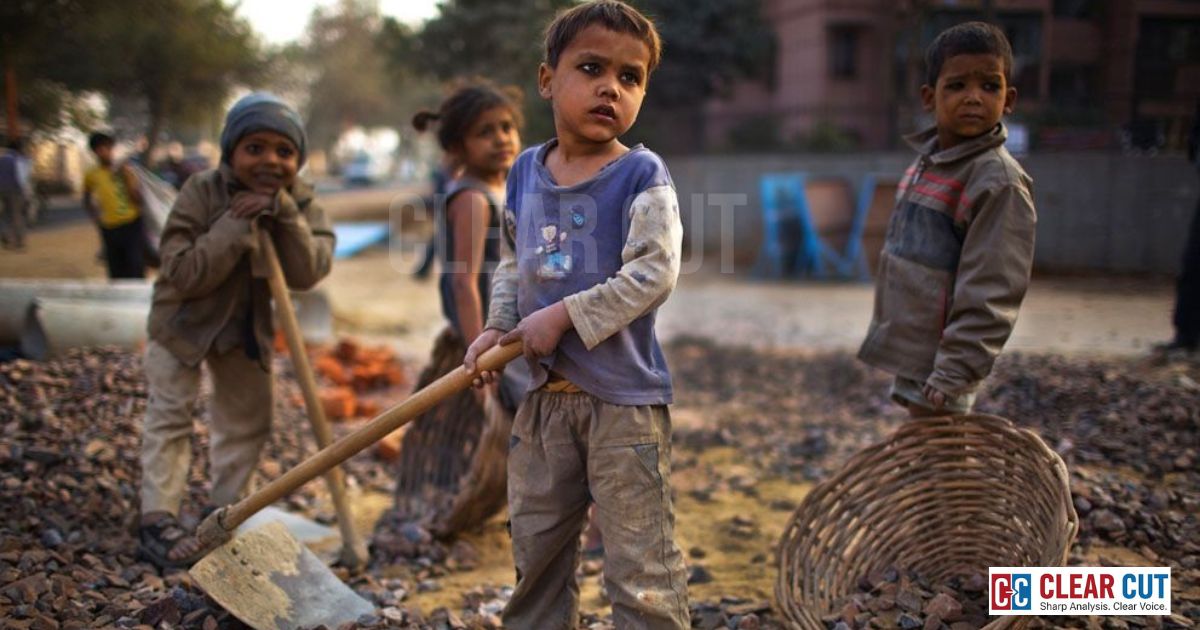Photo Credit : Ankita Shah
Clear Cut Child Protection Desk
New Delhi, UPDATED: Sep 16, 2025 11:20 IST
Written By: Janmojaya Barik
On a bustling Indian street, it is not difficult to find a child working. A twelve-year-old boy selling tea from a stall on the side of the road, a ten-year-old girl rolling beedis in the den of a dark house, or kids lugging bricks on a building site where they should be at school. These daily photos reveal an alarming reality that in spite of quick economic expansion and stringent legislation, lakhs of Indian kids are still ensnared in work.
The Scale of the Problem
India had more than 1 crore child laborers aged between 5 and 14 years, as per the Census of 2011. Activists are of the opinion that the figure will be higher in 2025, taking into account the sizeable informal sector where there is weak monitoring. The issue remains largely in the states of Uttar Pradesh, Bihar, Rajasthan, Madhya Pradesh, and Jharkhand, which collectively have a lion’s share of children at work.
A vast majority of child workers are in the informal sector, such as agriculture, construction, domestic work, roadside stalls, textile and carpet weaving, and small workshops. Their work remains invisible because it takes place inside homes or local neighborhood units, out of sight from inspectors.
Why Child Labor Exists
Numerous factors keep kids working rather than studying:
• Poverty and debt: Families living hand-to-mouth tend to rely on all sources of income, including children.
• Migration: Seasonal laborers take their children to urban areas, where education is interrupted.
• Weak enforcement: Regulations that are in place are not enough, as monitoring is limited and penalties are minimum.
• Social acceptance: In large parts of rural and semi-urban communities, child labor is viewed as “training” or a family contribution.
The COVID-19 pandemic accelerated the trend, forcing thousands of children back to work as schools closed and households fell further into poverty.
The Legal Framework
India has made firm commitments on paper.
• The Child Labor (Prohibition and Regulation) Amendment Act, 2016, prohibits employment of children below 14 years in all occupations except family enterprises.
• The Right to Education (RTE) Act, 2009, renders schooling free and compulsory for children up to 14 years of age.
• Rescue and rehabilitation programs, such as the National Child Labour Project (NCLP), offer educational facilities and training to rescued children.
For each child saved, scores of others are still concealed in factories, farms, or homes.
Corporates and civil society have filled some gaps.
• Bachpan Bachao Andolan, an organization established by Nobel Laureate Kailash Satyarthi, has saved more than 1 lakh children from work, trafficking, and abuse. Several of them are rehabilitated through education and vocational training.
• Akshaya Patra Foundation, with its CSR partners, provides hot midday meals to lakhs of children, easing the burden on families to take children to work for food.
These programs show the power of targeted policies to transform lives. Scores of children who previously labored in perilous industries now sit in classrooms with visions of futures beyond mere survival.
Why It’s Hard to Eliminate
Even with the strides, the obstacles are daunting:
• Subtlety of child labor in domestic and small-scale setups for detection.
• Rehabilitation gap: Others return to the workplace upon rescue because of the absence of support for families, which pushes them more into this void.
• Barriers to awareness: Parents and employers might not be aware of the long-term psych harm child labor inflicts.
• CSR imbalance: The majority of corporate contributions are spent on urban initiatives, with rural and tribal hubs, which are major hotspots, receiving short cuts of the scheme.
A Hopeful Picture
Experts opine that combating child labor must be taken up with community support and in the long term. Improving monitoring by panchayats, police, and schools can assist in making detection more effective. CSR funding ought to be allocated to education-linked, child labor prone district interventions.
Teenagers between the ages of 14 and 18, who are frequently drawn to dangerous work, require discipline and knowledge about job avenues to avoid exploitation. And above all, attitudes must be transformed, as a child is not an extra pair of hands but a student with a right to learn and play.
Child labor is not only a rights violation but also a national loss. Each child denied school today diminishes India’s future workforce and economy. Abolishing it will take better legislation, empathy, awareness, and sustained public action.
Each time a child is rescued and offered an opportunity at school, it doesn’t just change an individual’s life. It is a reminder that India’s growth narrative has to have its youngest citizens as part of it, not as factory and farm workers, but as students in schools, free to dream of better tomorrows.




